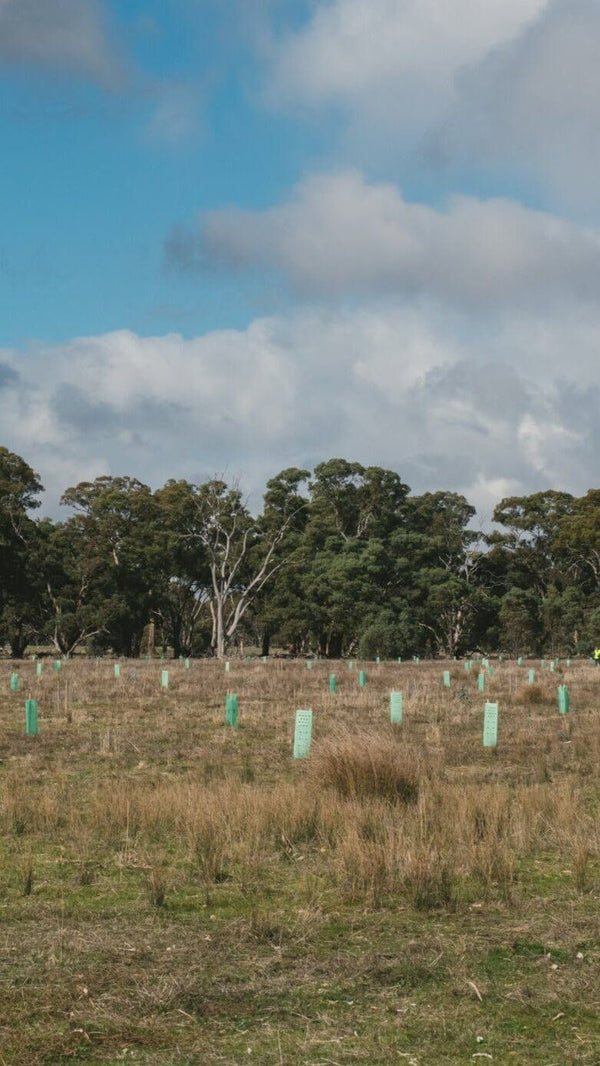This site is located on the lands of the Jardwadjali & Djabwurung people, adjacent to the northern part of the Grampians National Park in Victoria. Ledcourt was partially cleared for sheep and cattle grazing and is now being restored to protected native forest. With some remnant native vegetation already present on the site, Greenfleet is restoring the cleared areas and bolstering the existing ecosystems with ground cover species.

Location & Map
Ledcourt is adjacent to the northern part of the Grampians National Park in Victoria and adjoins Mount William Creek. This iconic region in Victoria is known for its native wildlife and birdlife. To the east of Ledcourt is mainly farmland, enhancing the need to extend the native ecosystems in the region.
This is one of many native reforestation projects that Greenfleet has undertaken in Victoria since 1997. To see where some of our other projects are growing, you can explore our forest map here.

Revegetation Approach & Species Selection
Multiple Ecological Vegetation Classes (EVCs) exist within the Wimmera bioregion where Ledcourt is located. Greenfleet is restoring four threatened woodland ecosystems across this project. Woodland ecosystems provide many benefits to the environment, such as improving soil and water quality and providing habitat for wildlife. They also help to sequester carbon and mitigate climate change by storing carbon in the soil and trees.
The endangered ecosystems within Ledcourt are the plains grassy woodland and plains woodland, with damp sands herb-rich woodland and riparian woodland listed as vulnerable.
We are working to plant species that will bolster the existing species and further strengthen the growth of these woodlands.
The planting at Ledcourt is being completed with a combination of seedlings and seeds sown into the soil. In total, we have planted 19 locally native tree and plant species at Ledcourt to restore the cleared areas and strengthen the remnant vegetation with ground cover species. As well as planting seedlings, 40 kilograms of seeds were dispersed across Ledcourt using drone technology.
Greenfleet has guarded some of the young seedlings planted at Ledcourt while they establish to protect them from browsing. Through our ongoing monitoring of the site, we will remove these guards over the coming years.
Species planted include Australian blackwood (Acacia melanoxylon), sweet bursaria (Bursaria spinosa) and prickly tea-tree (Leptospermum myrsinoides). Prickly tea-tree will provide refuge for small birds, with the flowers becoming a nectar source for birds, insects and butterflies. Greenfleet also planted yellow box (Eucalyptus melliodora) which is one of the four eucalypt species chosen to help form the forest canopy.

In 2024, further planting took place to include two rare and declining plant species as part of the unique restoration work occurring at the site. One of the species planted is the vulnerable buloke (Allocasuarina luehmannii). This tree grows up to 15 metres tall and supports a range of mammals, birds and reptiles such as legless lizards.
Wimmera scentbark (Eucalyptus sabulosa) is a flowering, fruiting tree found in Western Victoria that is also listed as vulnerable and included at Ledcourt. Existing populations are threatened by land clearing, grazing by introduced animals and habitation of exotic plants. As these and other species grow at Ledcourt, they will diversify the ecosystem growing at this forest and help bolster the prevalence of these species in the region.

Wildlife Habitat Restoration
The Grampians region is known for its picturesque views and hiking trails. The site at Ledcourt adjoins the Grampians National Park and the Mount William Creek, which is home to platypus, kangaroos, wallabies, echidnas and emus.
While koala populations can occur in the Grampians themselves, there have not been any near Ledcourt for many years. This is due to land clearing and a reduction in their habitat and food trees. One of the canopy species Greenfleet has planted at Ledcourt is river red gum (Eucalyptus camaldulensis) which is a preferred food source for koalas. By planting koala habitat and food trees, this forest may one day provide homes for these beloved animals.
The forest at Ledcourt is legally protected for 100 years so this long-term restoration work will provide potential habitat to many wildlife species as the forest grows.

Planting A Milestone Forest
If you are looking to celebrate an important life event sustainably, Greenfleet offers a unique way to grow a native forest and commemorate special occasions. When you invest in a Milestone Forest, your forest will be planted at Ledcourt and legally protected for 100 years.
The establishment of a ‘Milestone Forest’ will make a significant impact towards protecting our environment. Your support will help restore biodiverse ecosystems and re-connect habitat for wildlife, including many endangered species.
When passionate sustainability advocate Jeff Robinson passed away, his family was keen to ensure his legacy lived on.
Jeff’s community banded together, raising funds to plant a native biodiverse forest in his honour. In August 2024, his family, friends, and colleagues came to celebrate Jeff by planting trees at Ledcourt, forming part of Jeff Robinson's Sustainable Forest.
Location Size
105 hectares near the Grampians National Park in Victoria.
Planting Dates
2023, 2024
Species
- Gold-dust wattle (Acacia acinacea)
- Spreading wattle (Acacia genistifolia)
- Black wattle (Acacia mearnsii)
- Blackwood (Acacia melanoxylon)
- Golden wattle (Acacia pycnantha)
- Buloke (Allocasuarina leuhmannii)
- Slaty sheoak (Allocasuarina muelleriana)
- Silver banksia (Banksia Marginata)
- Sweet bursaria (Bursaria spinosa)
- Scarlet bottlebrush (Callistemon rugulosus)
- River red gum (Eucalyptus camaldulensis)
- Yellow gum (Eucalyptus leucoxylon)
- Yellow box (Eucalyptus melliodora)
- Wimmera scentbark (Eucalyptus sabulosa)
- Knobby club-rush (Ficinia nodosa)
- Bushy Needlewood (Hakea decurrens)
- Prickly tea-tree (Leptospermum continentale)
- Heath tea-tree (Leptospermum myrsinoides)
- Manuka (Leptospermum scoparium)
- Totem poles (Melaleuca decussata)


